Marinetti and the futurists believe in the future and in the new possibilities that the modern technology will bring. For this reason, Marinetti in his manifesto affirms that poets and the poetry need to abandon old myths, religious themes, and the tradition of the past, which are represented by the museums, defined the cemeteries of art and of the genius, to completely embrace modernity and reality. The world outside the museums is pulsing of new energy and producing constantly through new inventions of speed and the automobile. According to Marinetti, as the speed cancels time and space, the same must do the poetry. The new poetry will convey passion and violence to provoke and wake the instincts and the energies of the readers up.
In Rodchenko manifesto the artist thanks to the new technologies becomes the engineer of the future. He doesn’t relax with the new inventions, but he uses them to change everyday life and produce something for the society. The artist is not a dreamer anymore and he doesn’t create in his imagination, he creates a mug, a catalogue, boots for himself and for everybody. “Technology becomes the mortal enemy of the art”, where the artists are no longer slave workers of the traditional art and its rules. They create something that can be used for everyday life and not just admired and observed in museums.
El Lissitzky analyzing the evolution of the book in “Our book”, trusts the future inventions and technology evolutions which are pushed by the needs of the society, where the mass becomes the commissioner, bringing to the dematerialization. As we see the dematerialization of the communication from letters to telephones to the use of the radio, also the book was subject to the evolution of his forms according to the events, for example it becomes a poster in the years of the revolution and then through the photography and the collaboration with painters gave birth to the visual poetry realizing that the faster channel was the eye more than the ears (“the book’s facilities for expression take many more forms”). Moreover, he states that the shape and form of the book hasn’t been changed yet (probably because it didn’t reach yet that last state that is followed by the evolution) but he is quite satisfied with the fact that what it is inside the book, the design of the inside of the book reflects the evolution of his time. Furthermore, he underlines the importance of being in close contact with worldwide events and the progress of social development to be able to finally give a new effectiveness to the book.
Even though Marinetti, Rodchenko and El Lissitzky, they all promote the revolution of the poetry and art eliminating the rules of the past and have full confidence in the evolution of the technologies, they have different purposes. Marinetti purpose of the poetry is to show the beauty of the new technologies, to express the excitement, the energy and the violence of the artists promoting a war to destroy the religious and traditional ideas but also promoting a violent change in the society, a revolution. He wanted to take advantage of the new technological achievements for revolutionary purpose, for examples he uses the printing press to print in different formats that better would express the fervor and energy of his messages, persuading the reader. In Rodchenko and El Lissitzky works we can sense the exuberance and the desire to create something new in opposite to the past but with a mild tone and with the purpose of contributing to the everyday life and to the society. In particular, they wanted to eliminate the past to create new space to new ideas and new fast and exciting forms of art. Their works expressed the dynamism of the modern life, solving the problems of the modern life analyzing the modern materials. Constructivist artists were not focused on the composition, but on the construction.
As Marinetti, Rodchenko and Lissitzky embraced the modern technologies of their era, nowadays designers are constantly learning about new softwares and updating their skills to go hand in hand with the modern society and current technologies to express themselves. For this reason, I am curious about the evolution of the design in the next few years where computers are getting faster and computer screens probably will be substituted by 3d glasses and we will be able to see advertisement or probably read books not actually printed but virtually projected. In Rodchenko point of view, artists were not supposed to focus on expressing themselves but serve the society. Nowadays designers are socially responsible whenever they design something. The concept of using art and design to change the world is not new.




Recent Comments